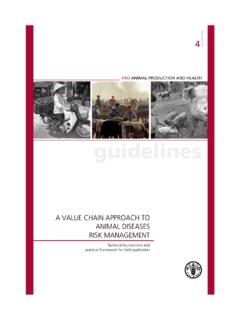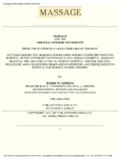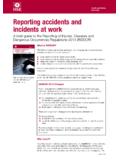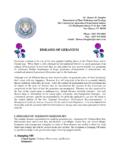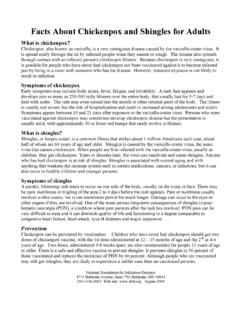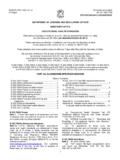Transcription of CHAPTER 6 Houseflies - World Health Organization
1 302 CHAPTER 6 HOUSEFLIESCHAPTER 6 HousefliesCarriers of diarrhoeal diseases and skin and eye infectionsThe common housefly, Musca domestica, lives in close association with people allover the World (Fig. ). The insects feed on human foodstuffs and wastes wherethey can pick up and transport various disease agents. In addition to the housefly,a number of other fly species have adapted to life in human settlements, where theypresent similar problems. In warmer climates, the filth fly, M. sorbens is of particu-lar interest in this regard. It is closely related to the housefly and consideredimportant in the spread of eye infections. Blowflies (Calliphoridae) and other flieshave been associated with the transmission of enteric cycleThere are four distinct stages in the life of a fly: egg, larva or maggot, pupa andadult (Fig.)
2 Depending on the temperature, it takes from 6 to 42 days for theegg to develop into the adult fly. The length of life is usually 2 3 weeks but incooler conditions it may be as long as three are usually laid in masses on organic material such as manure andgarbage. Hatching occurs within a few hours. The young larvae burrow into thebreeding material; they must obtain oxygen from the atmosphere and can, there-fore, survive only where sufficient fresh air is available. When the breeding me-dium is very wet they can live on its surface only, whereas in drier materials theymay penetrate to a depth of several larvae of most species are slender, white, legless maggots that developrapidly, passing through three instars. The time required for development variesfrom a minimum of three days to several weeks, depending on the species as wellas the temperature and type and quantity of food available.
3 After the feeding stageis completed the larvae migrate to a drier place and burrow into the soil or hideunder objects offering protection. They form a capsule-like case, the puparium,within which the transformation from larva to adult takes place. This usually takes2 10 days, at the end of which the fly pushes open the top of the case and worksits way out and up to the surface. Soon after emergence the fly spreads its wingsand the body dries and hardens. The adult fly is grey, 6 9 mm long and has fourdark stripes running lengthwise on the back. A few days elapse before the adult iscapable of reproduction. Under natural conditions an adult female rarely lays eggsmore than five times, and seldom lays more than 120 130 eggs on each male and female flies feed on all kinds of human food, garbage and excreta,including sweat, and on animal dung.
4 Under natural conditions flies seek a wideBIOLOGY303 Fig. life cycle of the fly ( WHO).BIOLOGY303 Fig. housefly (Musca domestica)(by courtesy of the Natural HistoryMuseum, London).304 CHAPTER 6 HOUSEFLIES variety of food substances. Because of the structure of their mouthparts, food mustbe either in the liquid state or readily soluble in the salivary gland secretions or inthe crop. Liquid food is sucked up and solid food is wetted with saliva, to bedissolved before ingestion. Water is an essential part of a fly s diet and flies do notordinarily live more than 48 hours without access to it. Other common sourcesof food are milk, sugar, syrup, blood, meat broth and many other materials foundin human settlements. The flies evidently need to feed at least two or three timesa sitesFemale flies deposit their eggs on decayed, fermenting or rotting organic materialof either animal or vegetable origin.
5 Unlike blowflies and fleshflies, housefliesrarely breed in meat or of accumulated animal faeces are among the most important breeding sitesfor houseflies. The suitability of dung for breeding depends on its moisture (nottoo wet), texture (not too solid) and freshness (normally within a week afterdeposition).Garbage and waste from food processingGarbage provides the main medium for breeding (Fig. ). It includes wasteassociated with the preparation, cooking and serving of food at home and in publicplaces, and with the handling, storage and sale of food, including fruits andvegetables, in manureFields that are heavily manured with organic matter such as dung, excrement,garbage and fish-meal may provide suitable breeding places for is the main medium for fly breeding in also breed in sewage sludge and solid organic waste in open drains,cesspools (underground pools for household sewage)
6 And plant materialsPiles of decaying grass clippings, compost heaps and other accumulations ofrotting vegetable matter serve as good breeding places for of adult fliesAn understanding of the ecology of flies helps to explain their role as carriers ofdisease and allows the planning of control measures. Adult flies are mainly activeduring the day, when they feed and mate. At night they normally rest, althoughthey adapt to some extent to artificial placesDuring the daytime, when not actively feeding, flies may be found resting onfloors, walls, ceilings and other interior surfaces as well as outdoors on the ground,fences, walls, steps, simple pit latrines, garbage cans, clothes lines, grasses night, flies are normally inactive. Their favourite resting places at this timeare ceilings and other overhead structures.
7 When temperatures remain high duringthe night, houseflies frequently rest out of doors on fences, clothes lines, electricwires, cords, weeds, grasses, hedges, bushes and trees. These resting places aregenerally near favoured daytime feeding and breeding areas and sheltered from thewind. They are usually above ground level, but rarely more than five metres in fly numbersFly numbers in a given locality vary with the availability of breeding places,sunshine hours, temperature and humidity. Fly densities are highest at meantemperatures of 20 25 C; they decrease at temperatures above and below thisrange and become undetectable at temperatures above 45 C and below 10 C. Atvery low temperatures, the species can stay alive in a dormant state in the adult orpupal and distributionDuring the day, flies are mainly gathered on or around feeding and breedingplaces, where mating and resting also take place (Fig.)
8 Their distribution isgreatly influenced by their reactions to light, temperature, humidity, and surfacecolour and texture. The preferred temperature for resting is between 35 C and40 C. Oviposition, mating, feeding and flying all stop at temperatures below15 are most active at low air humidities. At high temperatures (above 20 C),most houseflies spend the time outdoors or in covered areas near the open 6 HOUSEFLIESWhen not eating, flies rest on horizontal surfaces and on hanging wires andvertically suspended articles and ceilings indoors, especially at night. A detailedstudy of local resting places is essential for successful Health importanceNuisanceIn large numbers flies can be an important nuisance by disturbing people duringwork and at leisure.
9 Flies soil the inside and outside of houses with their can also have a negative psychological impact because their presence isconsidered a sign of unhygienic can spread diseases because they feed freely on human food and filthy matteralike. The fly picks up disease -causing organisms while crawling and that stick to the outside surfaces of the fly may survive for only a few hours,but those that are ingested with the food may survive in the fly s crop or gut forseveral days. Transmission takes place when the fly makes contact with people ortheir food (Fig. ). Most of the diseases can also be contracted more directlythrough contaminated food, water, air, hands and person-to-person contact. Thisreduces the relative importance of flies as carriers of market.
10 During the day adult flies can be found in large numbers on food tables, garbage andthe who keep cattle are sometimes surrounded by large numbers of filth flies (Musca sorbens),important vectors of certain eye diseases that flies can transmit include enteric infections (such as dysen-tery, diarrhoea, typhoid, cholera and certain helminth infections), eye infections(such as trachoma and epidemic conjunctivitis) (Fig. ), poliomyelitis andcertain skin infections (such as yaws, cutaneous diphtheria, some mycoses andleprosy).PUBLIC Health IMPORTANCE307 Fig. can be infected by eating food contaminated by 6 HOUSEFLIESC ontrol measuresFlies can be killed directly by insecticides or physical means such as traps, stickytapes, fly swats and electrocuting grids.











